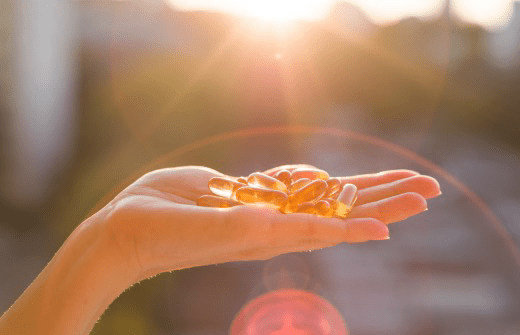October 20th is World Osteoporosis Day, so we decided to focus more on this topic in this article. Osteoporosis affects a large number of the population worldwide and shows an increasing trend. The diagnosis is often determined by an accident, for example in the case of a sudden fracture. Nevertheless, early detection of the disease can prevent further deterioration of bone quality as well as subsequent complications.
Article at a glanc:
- What is osteoporosis?
- Osteoporotic statistics
- Osteoporosis in the Czech republic
- Symptoms
- Who is at risk of osteoporosis?
- Prevention
- Non-pharmacological measures and their influence on bone quality
- A) Physical activity
- B) Nutrition
- Diagnosis
- Pharmacoteraphy
What is osteoporosis?
The word "osteoporosis" is of Latin origin and was formed by combining two Latin words "osteo" = bone and "porosis" = perforation, thinning.
Osteoporosis refers to a metabolic disease manifested by bone thinning and weakening of their structure. Bones become more fragile, their strength and elasticity decrease and they are more prone to fractures. Most often, osteoporosis is caused by a lack of sex hormones, physical activity and nutrients needed for healthy and strong bones.

Osteoporotic statistics
According to International Osteoporosis Foundation (IOF) statistics, one in three women and one in five men over the age of 50 will develop osteoporosis. At the age of 70, already every second woman suffers from osteoporosis. According to the World Health Organization (WHO), osteoporotic fractures are one of the main causes of illness and disability in the elderly population.
Osteoporosis in the Czech republic
IOF estimated that the number of individuals with osteoporosis in the Czech Republic in 2019 was approximately 572,000 (5.0% of the total population). Approximately 91,000 new fragility fractures occurred in 2019, estimated to increase by 34.8% in 2034 (123,000 fractures in 2034). The economic burden of new and prior fractures was €396 million in 2019 (2.7% of total national healthcare spending), increased by €123 million compared to 2010 (€273 million in 2010). The proportion of women at high fracture risk who did not receive treatment (treatment gap) was 79% in 2019 (up from 76% in 2010).
Symptoms
The development of osteoporosis is slow and this disease can be painless for a long time. Symptoms of early-stage osteoporosis include receding gums, weak and brittle fingernails and weak grip strength. A 2018 study [1] of 120 postmenopausal women confirmed that low handgrip strength is linked to low bone mineral density and can increase a risk for falls.
Signs and symptoms of later-stage osteoporosis include back pain and loss of height. However, it is not rare that only the first fracture (that can be spontaneous or from a minor movement), leads to the diagnosis of osteoporosis. These are mainly fractures of vertebrae, femoral necks and forearms.
Who is at risk of osteoporosis?
It is generally known that post-menopausal women are at the highest risk due to reduced estrogen production. This hormone provides protection to the bones by suppressing the activity of osteoclasts (= bone cells that are responsible for breaking down bone tissue). Osteoporosis also affects older people, especially those over 60.
Other risk factors include:
- early menopause and low estrogen levels in women,
- family history of osteoporosis,
- lack of physical activity,
- lack of certain vitamins and minerals (like vitamin D, vitamin K2, calcium, magnesium),
- low body weight,
- excessive alcohol consumption,
- smoking,
- certain medications (mainly glucocorticoids),
- some chronic diseases (e.g. diabetes, celiac disease or other intestinal malabsorption diseases, kidney diseases, disorders of the thyroid gland and parathyroid glands).
Prevention
Prevention is always better than cure. If we want to focus on prevention from the very beginning, it is necessary for pregnant women to think about their balanced diet that will support a healthy development of the fetus.
A very important period for the prevention of osteoporosis is childhood and adolescence, the period of forming bone tissue. The foundations of healthy bones are largely built in the first two decades of our lives. Therefore, osteoporosis is sometimes characterized as a pediatric disease with geriatric consequences.
Regular physical activity and a balanced diet with sufficient intake of protein, vitamin D & vitamin K2 as well as minerals such as calcium and magnesium play an important role in building healthy bones. All these factors fundamentally affect bone quality for the rest of our lives.
Non-pharmacological measures and their influence on bone quality
A) Physical activity
Regular physical activity like walking is the basis of non-pharmacological measures to prevent osteoporosis. Physical activity has a complex effect on bones - it supports the building of bone mass by activating osteoblasts (bone cells involved in bone formation), improves muscle strength as well as body stability.
B) Nutrition
A balanced diet plays a key role in maintaining bone and muscle mass. The most important nutrients for healthy bones include vitamin D and vitamin K2, calcium, magnesium and proteins. Additionally, the intestinal absorption decreases with age. This leads to the reduction of important nutrients that are needed for the prevention of osteoporosis. Other dietary factors that can adversely affect bone health include excessive consumption of alcohol and caffeine.
Vitamin DVitamin D plays a key role in the development and maintenance of healthy bones by supporting the absorption of calcium from food. It also ensures proper bone repair and mineralization. Some studies connect a low level of vitamin D during pregnancy with reduced bone density in children as well as with other health consequences [2] [3]. Vitamin D deficiency in children can lead to growth retardation and bone deformities known as rickets. Vitamin D deficiency in adults causes osteomalacia, which is softening of the bones due to their poor mineralisation.
Vitamin D deficiency is unfortunately quite common and can contribute to osteoporosis. It is assumed that up to ⅔ of patients with osteoporosis suffer from a lack of this vitamin.
Vitamin K2
Osteoblast bone cells produce a protein called osteocalcin that binds calcium to bones, helping to build healthy, strong bones. However, osteocalcin needs a sufficient amount of vitamin K2 for its activation.
A ground-breaking, double-blind, randomized, clinical trial [4] published in the prestigious Osteoporosis International Journal (2013) demonstrated for the first time that sufficient amounts of vitamin K2 can significantly help protect bones from their weakening and thinning and protect against the risk of fractures. In this 3-year study of 244 healthy postmenopausal women who supplemented 180mcg of vitamin K2 daily, bone strength and mineral density increased significantly compared to the placebo group.
Magnesium
Approximately half of the total magnesium content of the body is stored in the skeleton. Magnesium plays an important role in bone formation by promoting the proliferation of osteoblasts. The absorption of magnesium decreases with age, that’s why older people are at higher risk of magnesium deficiency.
Calcium
Calcium is the main building material of our skeleton. Almost 99% of calcium in the adult body is found in our bones and teeth, where it is stored in the form of a mineral complex called hydroxyapatite. Calcium is also used for muscle contraction, nerve transmission and blood clotting. For this reason, it is necessary that its level in the blood is constantly regulated. If blood calcium levels drop, parathyroid hormone from the parathyroid glands causes the skeleton to release calcium into the bloodstream to balance circulating calcium concentrations. Bones therefore function as a "reservoir" of calcium.
Proteins
Proteins provide the body with a source of amino acids to support building of the bone mass. Differences in protein intake during childhood and adolescence may affect skeletal growth and modulate the genetic potential for peak bone mass. Older people are more often in protein deficiency, which can cause decrease of muscle mass and bone mineral density. Ensuring sufficient protein intake, especially in the elderly, can reduce the risk of falls and thus osteoporotic fractures.
Alcohol
If you do decide to drink alcohol, moderation is the bone healthy choice. According to a study [5] published in Osteoporosis International (2005), for both men and women, more than two units of alcohol per day can increase the risk of osteoporotic fracture, while more than four units per day can double the risk of fractures.
Caffeine
Caffeine increases urinary and faecal calcium losses and thus has the potential to adversely affect bone health. A Swedish study [6] suggests that caffeine intake of 330 mg per day (roughly four cups of coffee) may be associated with a 20% increased risk of osteoporotic fractures, compared to caffeine intake of less than 200 mg per day. However, increasing calcium intake by 40 mg for each cup of caffeinated coffee consumed may offset calcium loss. [7]
Diagnosis
Osteoporosis is diagnosed by determining bone density by densitometric examination, DXA (=Dual energy X-ray Absorptiometry), in the area of the lumbar spine and proximal femur. This is a low-load X-ray examination that assesses the mineral content in the measured area of the bone. This examination can reveal both osteoporosis as well as less serious bone damage - osteopenia. In the Czech Republic, DXA is covered by health insurance for women after menopause, for women over 50, or for high-risk patients (for example, long-term users of corticosteroids, individuals with low body weight or people older than 60 years). If the indication for the examination is not provided by a doctor, it is possible to pay for it as a self-payer.
Pharmacotherapy
Previously, osteoporosis was treated only with calcium and vitamin D. Today, other drugs are also used for treatment, including hormone replacement therapy (HRT) or selective estrogen receptor modulators (SERM). Another group consists of the so-called bisphosphonates that suppress bone resorption. Bisphosphonates are one of the most frequently prescribed drugs for the majority of elderly people suffering from osteoporosis.
Sources:
[1] Li YZ, Zhuang HF, Cai SQ, Lin CK, Wang PW, Yan LS, Lin JK, Yu HM. Low Grip Strength is a Strong Risk Factor of Osteoporosis in Postmenopausal Women. Orthop Surg. 2018 Feb;10(1):17-22. doi: 10.1111/os.12360. Epub 2018 Feb 12. PMID: 29430846; PMCID: PMC6594500.
[2] Javaid MK, Crozier SR, Harvey NC, Gale CR, Dennison EM, Boucher BJ, Arden NK, Godfrey KM, Cooper C; Princess Anne Hospital Study Group. Maternal vitamin D status during pregnancy and childhood bone mass at age 9 years: a longitudinal study. Lancet. 2006 Jan 7;367(9504):36-43. doi: 10.1016/S0140-6736(06)67922-1. Erratum in: Lancet. 2006 May 6;367(9521):1486. PMID: 16399151.
[3] Congdon P, Horsman A, Kirby PA, Dibble J, Bashir T. Mineral content of the forearms of babies born to Asian and white mothers. Br Med J (Clin Res Ed). 1983 Apr 16;286(6373):1233-5. doi: 10.1136/bmj.286.6373.1233. PMID: 6404403; PMCID: PMC1547285.
[4] Knapen MH, Drummen NE, Smit E, Vermeer C, Theuwissen E. Three-year low-dose menaquinone-7 supplementation helps decrease bone loss in healthy postmenopausal women. Osteoporos Int. 2013 Sep;24(9):2499-507. doi: 10.1007/s00198-013-2325-6. Epub 2013 Mar 23. PMID: 23525894.
[5] Kanis JA, Johansson H, Johnell O, Oden A, De Laet C, Eisman JA, Pols H, Tenenhouse A. Alcohol intake as a risk factor for fracture. Osteoporos Int. 2005 Jul;16(7):737-42. doi: 10.1007/s00198-004-1734-y. Epub 2004 Sep 29. PMID: 15455194.
[6] Hallström H, Wolk A, Glynn A, Michaëlsson K. Coffee, tea and caffeine consumption in relation to osteoporotic fracture risk in a cohort of Swedish women. Osteoporos Int. 2006;17(7):1055-64. doi: 10.1007/s00198-006-0109-y. Epub 2006 May 4. PMID: 16758142.
[7] Barrett-Connor E, Chang JC, Edelstein SL (1994) Coffee-associated osteoporosis offset by daily milk consumption. The Rancho Bernardo Study. JAMA 271:280-283
Ponsonby AL, Lucas RM, Lewis S, Halliday J. Vitamin D status during pregnancy and aspects of offspring health. Nutrients. 2010 Mar;2(3):389-407. doi: 10.3390/nu2030389. Epub 2010 Mar 23. PMID: 22254029; PMCID: PMC3257641.
https://www.osteoporosis.foundation
https://www.kardiologickarevue.cz/casopisy/kardiologicka-revue/2014-5/diagnostika-a-lecba-osteoporozy-50151

















